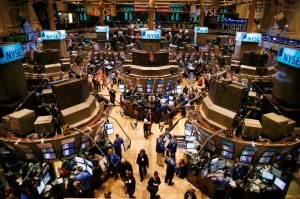
How much is HFT costing you?
Michael Lewis’ book Flash Boys has shed some much-needed light on the practices of high frequency traders and the use by brokers of dark pools to execute trades.
To give a simple example of the situation, when a buy order is executed, it will often be split up into smaller pieces, with each piece being sent to a different trading venue to take advantage of the sell orders on offer in each venue. The problem is that all the pieces arrive at the different venues at slightly different times, and a high frequency trader who sees the first piece arrive at one venue, can quickly put buy orders into the other venues to soak up the selling volume before the other pieces arrive. The HFT can then turn around and sell those pieces to the original buyer at a slightly higher price.
It is sometimes claimed that HFT contributes to the operation of the markets by adding liquidity, but in this example the HFT is contributing nothing. Certainly the apparent liquidity is higher, because two trades have happened instead of one, but nobody benefits from this apparent liquidity other than the HFT. Profits made by the HFT can only come out of the pockets of the other buyers and sellers.
These profits are not large as a fraction of the value of shares traded, and the position in Australia is less worrisome than the position in the US, where a large percentage of all volume is now accounted for by HFT. However, I am struggling to see how HFT can be anything other than a net negative from the perspective of normal investors and for the efficient allocation of capital to business enterprises. It’s good to see these practices being brought to the surface and properly debated.
Andrew Legget
:
Would one way to comabt HFT be to not buy/sell through “at market” orders? This would appear on first thought to stop the HFT systems from getting in between and scalping a small profit.
Can’t help but think that this (and no doubt future technological advances) is perhaps also going to put some more nails in the EMH coffin. It is quite clear that certain participants have an advantage over others and there for it is no doubt an arguement that this is a form of inefficiency.
In saying that, i do believe that EMH is such a wide ranging theory that it is almost impossible to prove wrong in general as there is always an out through the different forms etc. I also don’t think it is a bad thing that people believe it but i am getting off topic.
gordon alford
:
I agree with you. This seems to be one of the new trading avenues only available to the big boys. The stock market seems more open to manipulation by “players” than ever before with 5/10% price fluctuations quite common even when there is no news from a particular company. This makes small investors particularly nervous and I think prevents would be stock holders from investing in shares.
Piotr
:
I’m sorry Roger but I do not agree with you. The way I see it is that if you put a sell order out at $x you are happy to accept $x for your shares.
If someone comes along and can buy at less than $x and sell to you at $x then good on them. You have not lost anything because you still have received a price that you are happy to accept.
tim-kelley-7146
:
Hi Piotr. A small order can certainly be managed in that way. However, a larger sell order can only be be completed over time, and with the price changing during that time. The problem for such an order is that HFT can push the price down during execution, and the seller must choose to either stop selling when the price moves beyond a limit, or keep selling at a less favourable price. Both outcomes are undesirable for the seller.